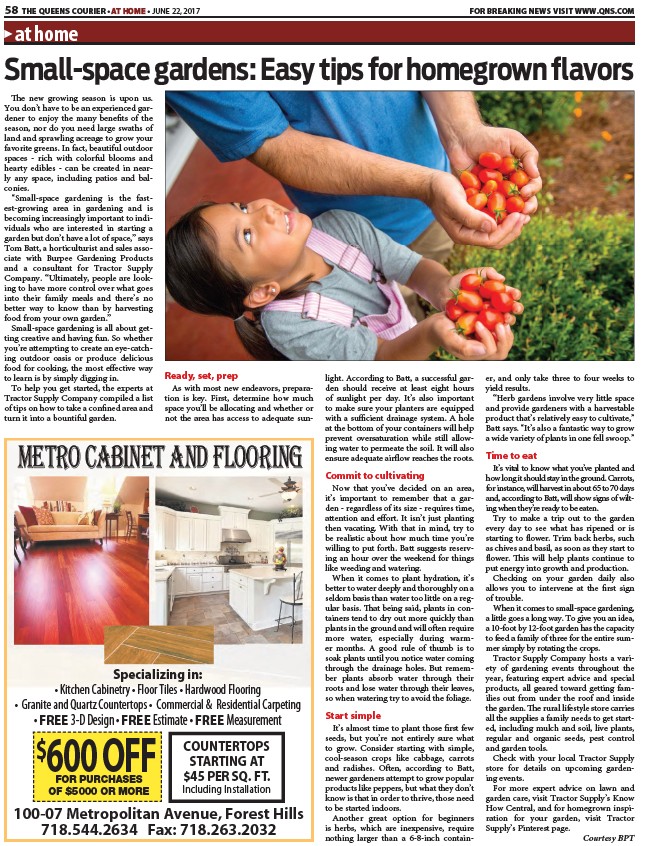
58 THE QUEENS COURIER • AT HOME • JUNE 22, 2017 FOR BREAKING NEWS VISIT WWW.QNS.COM
at home
Small-space gardens: Easy tips for homegrown fl avors
Th e new growing season is upon us.
You don’t have to be an experienced gardener
to enjoy the many benefi ts of the
season, nor do you need large swaths of
land and sprawling acreage to grow your
favorite greens. In fact, beautiful outdoor
spaces - rich with colorful blooms and
hearty edibles - can be created in nearly
any space, including patios and balconies.
“Small-space gardening is the fastest
growing area in gardening and is
becoming increasingly important to individuals
who are interested in starting a
garden but don’t have a lot of space,” says
Tom Batt, a horticulturist and sales associate
with Burpee Gardening Products
and a consultant for Tractor Supply
Company. “Ultimately, people are looking
to have more control over what goes
into their family meals and there’s no
better way to know than by harvesting
food from your own garden.”
Small-space gardening is all about getting
creative and having fun. So whether
you’re attempting to create an eye-catching
outdoor oasis or produce delicious
food for cooking, the most eff ective way
to learn is by simply digging in.
To help you get started, the experts at
Tractor Supply Company compiled a list
of tips on how to take a confi ned area and
turn it into a bountiful garden.
Ready, set, prep
As with most new endeavors, preparation
is key. First, determine how much
space you’ll be allocating and whether or
not the area has access to adequate sunlight.
���������� ����������������������������������������
Specializing in:
����������������������������������������������������������������������������������������������������������
������������������������������������������������������������������������������������������������������������������������������������������������
����FREE����������������������������FREE������������������������FREE������������������������
COUNTERTOPS
STARTING AT
$45 PER SQ. FT.
Including Installation
600 OFF FOR PURCHASES
OF $5000 OR MORE
$
100-07 Metropolitan Avenue, Forest Hills
718.544.2634 Fax: 718.263.2032
According to Batt, a successful garden
should receive at least eight hours
of sunlight per day. It’s also important
to make sure your planters are equipped
with a suffi cient drainage system. A hole
at the bottom of your containers will help
prevent oversaturation while still allowing
water to permeate the soil. It will also
ensure adequate airfl ow reaches the roots.
Commit to cultivating
Now that you’ve decided on an area,
it’s important to remember that a garden
- regardless of its size - requires time,
attention and eff ort. It isn’t just planting
then vacating. With that in mind, try to
be realistic about how much time you’re
willing to put forth. Batt suggests reserving
an hour over the weekend for things
like weeding and watering.
When it comes to plant hydration, it’s
better to water deeply and thoroughly on a
seldom basis than water too little on a regular
basis. Th at being said, plants in containers
tend to dry out more quickly than
plants in the ground and will oft en require
more water, especially during warmer
months. A good rule of thumb is to
soak plants until you notice water coming
through the drainage holes. But remember
plants absorb water through their
roots and lose water through their leaves,
so when watering try to avoid the foliage.
Start simple
It’s almost time to plant those fi rst few
seeds, but you’re not entirely sure what
to grow. Consider starting with simple,
cool-season crops like cabbage, carrots
and radishes. Oft en, according to Batt,
newer gardeners attempt to grow popular
products like peppers, but what they don’t
know is that in order to thrive, those need
to be started indoors.
Another great option for beginners
is herbs, which are inexpensive, require
nothing larger than a 6-8-inch container,
and only take three to four weeks to
yield results.
“Herb gardens involve very little space
and provide gardeners with a harvestable
product that’s relatively easy to cultivate,”
Batt says. “It’s also a fantastic way to grow
a wide variety of plants in one fell swoop.”
Time to eat
It’s vital to know what you’ve planted and
how long it should stay in the ground. Carrots,
for instance, will harvest in about 65 to 70 days
and, according to Batt, will show signs of wilting
when they’re ready to be eaten.
Try to make a trip out to the garden
every day to see what has ripened or is
starting to fl ower. Trim back herbs, such
as chives and basil, as soon as they start to
fl ower. Th is will help plants continue to
put energy into growth and production.
Checking on your garden daily also
allows you to intervene at the fi rst sign
of trouble.
When it comes to small-space gardening,
a little goes a long way. To give you an idea,
a 10-foot by 12-foot garden has the capacity
to feed a family of three for the entire summer
simply by rotating the crops.
Tractor Supply Company hosts a variety
of gardening events throughout the
year, featuring expert advice and special
products, all geared toward getting families
out from under the roof and inside
the garden. Th e rural lifestyle store carries
all the supplies a family needs to get started,
including mulch and soil, live plants,
regular and organic seeds, pest control
and garden tools.
Check with your local Tractor Supply
store for details on upcoming gardening
events.
For more expert advice on lawn and
garden care, visit Tractor Supply’s Know
How Central, and for homegrown inspiration
for your garden, visit Tractor
Supply’s Pinterest page.
Courtesy BPT